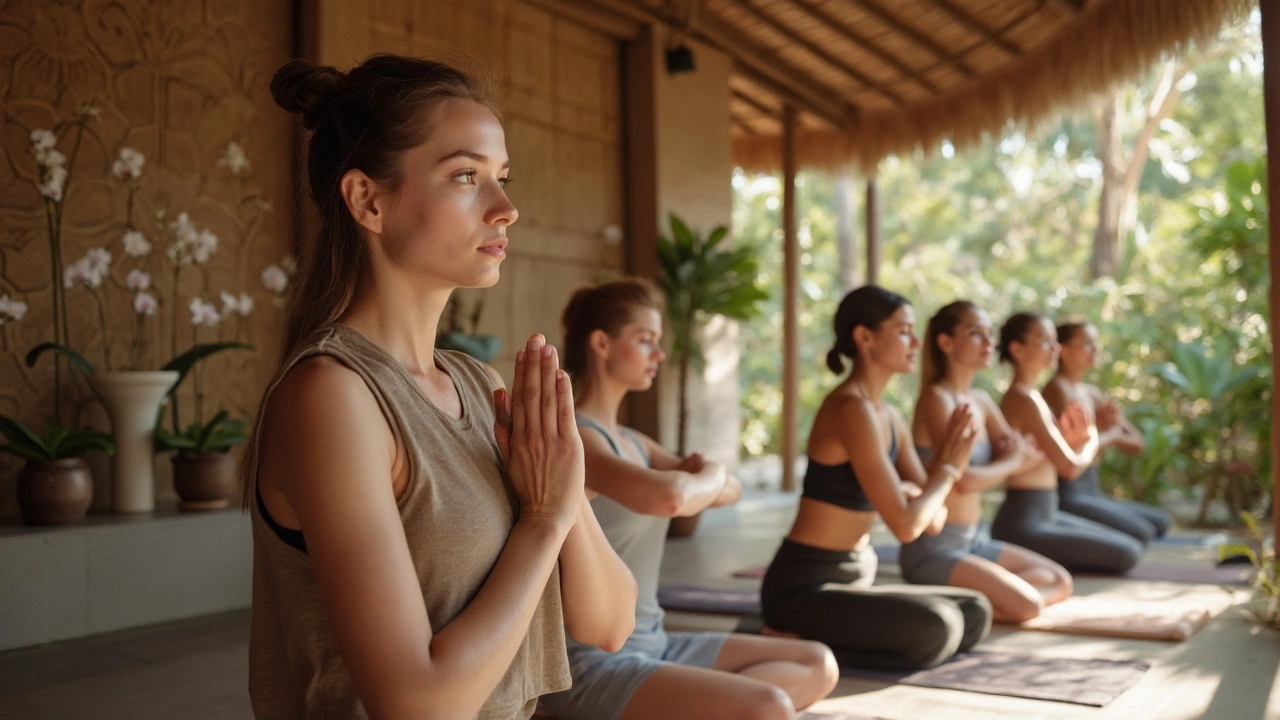What to Expect During Your First Thai Massage: An Honest Beginner’s Guide

Not sure what it's really like to get your first Thai massage? You’re not alone—it can feel a little mysterious if all you know is the usual Western-style spa. Instead of lying under soft sheets and drifting off to spa music, you’ll be fully dressed, stretched in ways you didn’t know you could move, and sometimes even walked on (yes, for real!). Thai massage isn’t your everyday shoulder rub. It’s an ancient blend of yoga-like stretches, slow pressure, and a touch of meditation.
You might hear the word “energy lines” tossed around, which sounds a bit mystical, but really it’s about loosening tight muscles and getting your body to relax from the inside out. If you’re new to the scene, you probably have a million questions: Should you eat first? Do you talk? What do you even wear? The good news: I’ll explain the real deal and break down what you’ll actually do, see, and feel during a session. You’ll walk in feeling curious and walk out feeling like jelly—in the best way. Let’s get straight to what matters most so you know exactly what to expect.
- Key Things to Know Before You Go
- How Thai Massage Works and What Makes It Unique
- Real Benefits of Thai Massage (Beyond Just Relaxation)
- Step-by-Step: Your First Thai Massage Experience
- Simple Tips for a Better, Safer Session
Key Things to Know Before You Go
Walking into your first thai massage can be a little nerve-wracking, especially if you only know about the classic oil massages. Here’s what you really need to know to avoid surprises.
- Dress the Part. No need to strip down—most places give you loose, comfy clothes to wear. If they don’t, just show up in stretchable pants and a T-shirt. Forget tights, skirts, or anything stiff.
- Arrive With Time to Spare. Try to get there 10–15 minutes early. This isn’t just polite—it gives you time to fill out simple health forms and use the bathroom first. Trust me, you don’t want to pause mid-massage for a bathroom break.
- Skip the Heavy Meal. Avoid eating a big meal right before. Deep stretches and full tummies don’t mix. A light snack is fine if you’re hungry, but save the feast for after.
- Share Your Health History. Be upfront with your therapist about any injuries, surgeries, or medical conditions. They’ll appreciate it, and your session will be much safer (nobody wants their old knee injury flared up halfway in).
- Know Your Comfort Zone. Some stretches are deep, and the pressure can get intense. You’re always allowed to speak up, so don’t be shy if you need things gentler or want to skip a certain move.
- No Oil Here. Unlike Swedish or deep tissue massage, traditional thai massage is done dry and fully clothed. There’s no need for towels or slippery skin.
| What to Bring | Why It's Useful |
|---|---|
| Comfortable, clean socks | You keep your socks on, and clean feet = good vibes for everyone. |
| Hair tie | Long hair just gets in the way during stretches and moves. |
| Water bottle | Staying hydrated helps with muscle recovery. |
One thing most beginners don’t know: you’ll spend lots of your session on a thick mat on the floor—not a massage table. This makes it easier for your therapist to use their hands, elbows, knees, and sometimes even their feet to work those muscles and joints.
If you’re worried about privacy, relax. Your body will stay decently covered the whole time. The focus is on stretching and pressure points—a totally different vibe from oil massages.
How Thai Massage Works and What Makes It Unique
So, what’s the real story behind a thai massage? It comes from ancient Thailand (no surprise there), and it’s over 2,500 years old. The roots actually trace back to Indian healing traditions. But don’t expect candles and oil—this massage goes straight to work, using stretches and pressure instead of long glides or muscle kneading.
During your first thai massage experience, you’ll notice you keep all your clothes on—usually comfy pants and a tee are perfect. The therapist doesn’t just use hands. They may also use elbows, forearms, knees, and even feet. They’ll guide you through stretches that feel a lot like partner yoga but with zero effort on your part. Seriously, you just relax and let them do all the heavy lifting (sometimes literally!).
What really makes this style of massage different? Here are a few things:
- No oils or lotions. This means no sticky or slippery aftermath. Perfect if the thought of oily skin makes you cringe.
- Active stretching. You might find your body twisted, extended, or gently rocked. Think of it as assisted yoga.
- Focus on energy lines. In Thai tradition, energy moves through your body along what’s called "Sen" lines. Therapists work these lines by applying pressure and stretches aiming to balance energy and settle tension.
- Mat on the floor. Forget massage tables. Most sessions take place on a firm mat, which helps the therapist get leverage for deeper stretches.
- Communication is key. Not all pressure feels the same to everyone. The therapist will often check in about your comfort, so don’t be shy about saying you need it softer or stronger.
Some spas offer fusion styles that blend thai massage with Western techniques. But classic Thai massage sticks to the basics: stretching, pressure, and that magic feeling of having all your knots worked out at once.
Curious about what happens in a typical session? On average, a full body Thai massage lasts 60 to 90 minutes. The therapist tends to start with your feet, working their way up, covering legs, back, shoulders, arms, and sometimes even your head and face.
Check out this simple table showing the main differences between Thai massage and Swedish massage, which most people are familiar with:
| Thai Massage | Swedish Massage |
|---|---|
| Fully clothed, no oils | Undressed, uses oils |
| On a firm mat, often on the floor | On a padded table |
| Stretching + deep pressure | Long, gliding strokes |
| Therapist may use whole body to apply pressure | Usually just hands and forearms |
Once you’ve experienced a real Thai massage, going back to a simple back rub just feels… basic. The next section breaks down why so many people swear by these sessions, beyond just feeling relaxed.

Real Benefits of Thai Massage (Beyond Just Relaxation)
Sure, everyone loves the idea of being pampered and relaxed. But thai massage goes above and beyond the usual chill-out session. Most newbies are surprised to find they feel more awake and loose after a session than sleepy. It's not just about relaxing; it's about recharging your body and even helping it work better day-to-day.
One huge plus: flexibility. Those gentle (and sometimes deep) stretches target muscles you probably forget you have. Regular thai massage has been shown to improve mobility in joints and ease back and shoulder tightness, especially if you’re sitting at a desk all day. If you play sports, it can help you bounce back faster after workouts too.
And then there’s pain relief. Research from the Journal of Bodywork and Movement Therapies found that Thai massage helps people with chronic low back pain feel better and move easier. That’s because the method works your muscles in a hands-on way but also gets your blood flowing. Better circulation means your body heals and recovers quicker, which is a big deal if you’re always feeling stiff or sore.
Check out this handy table for a quick look at how thai massage stacks up for common issues:
| Issue | Thai Massage Impact |
|---|---|
| Chronic Back Pain | Reduces pain, increases mobility |
| Poor Flexibility | Boosts range of motion, feels less tight |
| Stress/Anxiety | Calms nerves, leaves you feeling grounded |
| Post-Exercise Soreness | Speeds up recovery, lessens muscle ache |
Don’t forget about mental perks. Deep breathing is woven through every thai massage, so you might leave feeling clear-headed, more focused, and just a little happier. Some folks even use it as a way to reset after tough days at work or after a string of bad nights’ sleep. If you’re the type who can’t sit still during a regular massage, the stretches and movement during Thai massage make it way more engaging. It’s like yoga, but someone else is doing all the work for you.
Step-by-Step: Your First Thai Massage Experience
Let’s get right into what actually happens during your first thai massage. No wild surprises—just some new stuff if you're used to basic spa massages.
- Arriving and Getting Ready: When you show up, the receptionist might ask you to fill out a quick form about your health history—stuff like back injuries, pregnancy, or recent surgeries. This helps keep you safe. They'll hand you loose, comfy clothes to change into (think pajama pants and a T-shirt). Most places have a private room or curtained-off area for changing, so no worries there. No oils or lotions are used, which means you stay fully dressed for the session.
- Setting the Scene: Thai massage happens on a firm mat on the floor, not a high massage table. Shoes come off, but socks can stay if you want. The room is usually quiet, maybe with some light music or incense, but it’s nothing too intense. If you feel chilly, just ask for a blanket.
- Beginning the Massage: Your therapist starts at your feet and works upward. Expect light pressure, gentle rocking, and slow stretches. They may use their hands, elbows, knees, or even feet—yep, walking gently on your back or legs is common! You might be surprised by how relaxing it is, even when you’re moved into yoga-like positions. There’s a rhythm to Thai massage that helps you drift off mentally.
- During the Session: Communication is key. If anything feels too strong or not strong enough, just speak up. Thai massage is supposed to reach that "good pain" level—never sharp or agonizing. If you feel a stretch is too much, say so. Therapists are used to tailoring the session for beginners. You’ll sometimes hear instructions to breathe deeply and relax different muscle groups.
- After the Massage: The therapist may guide you to slowly sit up at the end. You’ll probably feel looser and surprisingly energized, sometimes even a bit taller (even though that’s just your posture, not magic). Drink a glass of water—they’ll usually offer it—and move around slowly as you get your bearings. Most places give you time and privacy to change back into your clothes before heading out.
Sessions usually run between 60 to 90 minutes. Shorter sessions focus more on the back and shoulders, while longer ones get you stretched from head to toe. Here’s a quick snapshot:
| Session Length | Typical Coverage |
|---|---|
| 60 minutes | Back, shoulders, neck |
| 90 minutes | Full body, feet to head |
| 120 minutes | Full body, deeper stretches, more relaxation time |
Your first thai massage experience isn’t about getting everything perfect—it’s about discovering a whole new way to unwind. Just show up curious and ready to try something different.

Simple Tips for a Better, Safer Session
You want your first thai massage to hit the spot, not leave you feeling awkward or stiff. A little preparation goes a long way, both for comfort and safety. Here’s what actually makes a difference:
- Wear loose, comfy clothes. Skip jeans, skirts, or anything tight. Most places give you pants and a top, but bring your own if you want. You’ll stretch a lot, so think yoga-style.
- Skip big meals beforehand. Arriving with a full stomach just makes you uncomfortable. Give yourself at least an hour after eating.
- Speak up, always. If a stretch or pressure feels like too much, tell your therapist right away. Some spots are meant to hurt slightly (like a good stretch), but sharp pain is a no-go.
- Take off jewelry and watches. They get in the way, and metal can dig in during stretches.
- Stay hydrated. Drink water before and especially after your session. Thai massage helps your body flush out “gunk” (think of that groggy, post-massage feeling), and water speeds up recovery.
- Health issues? Say so. Pregnant, recent surgeries, or have injuries? Let the therapist know up front. Some positions can be risky if you don’t mention it.
- Arrive a few minutes early. Rushing in stressed means you won’t get the full benefit. A few minutes to settle in makes a big difference.
It’s helpful to know that legitimate thai massage therapists in reputable spas should ask a few questions about your medical history before you start. This isn’t nosiness—it’s to keep you safe. If they don’t, take the lead and mention anything important, just in case.
If you’re dealing with inflammation, an open wound, or a fever, it’s better to reschedule. Even if you’re just feeling ‘off,’ a break is less hassle than getting sick or injured from a session meant for relaxation. For reference, here’s a quick breakdown of when to go ahead or hold off on booking:
| Condition | Okay to Book? |
|---|---|
| Minor muscle soreness | Yes |
| Pregnant (first trimester) | No |
| Recent surgery (<6 months) | No |
| Cold/Flu symptoms | No |
| General stress or tiredness | Yes |
One last thing—during your thai massage experience, remember it’s totally normal to need a bathroom break or to shift position. Don’t feel weird about it! Your comfort comes first. The best session is one where you feel relaxed, safe, and cared for from start to finish.



